Bulletin – March 2017 Global Economy Inflation Expectations in Advanced Economies
- Download 1.45MB
Abstract
Anchored inflation expectations are important for price stability because expectations affect current actions. Although all inflation expectations measures provide some information about future inflation, professional forecasters have been the most accurate in predicting future inflation, while market-implied and consumer measures have tended to be less so. Recent declines in inflation expectations have been concentrated in the measures that have historically been less accurate predictors. The more accurate measures have been more stable and have remained close to central banks' inflation targets.
Introduction
After declining during the global financial crisis (GFC), inflation rates in advanced economies have remained low and below most central banks' targets for an extended period, although headline inflation has picked up in some economies more recently. The low inflation experience has been mainly caused by the slow economic recovery, which has only very gradually absorbed the spare capacity in labour and product markets. Such a protracted period of low inflation could, in principle, lead economic agents to expect that inflation in the future would remain low and below central banks' inflation targets. Understanding whether low inflation expectations have become entrenched is important for monetary policy decision-making because expectations affect current economic decisions.
A number of measures of inflation expectations are available but some are better indicators of future inflation than others. Understanding which of these measures are the most informative about future inflation is crucial for monitoring developments in inflation expectations. This article assesses how well three widely available types of inflation expectations measures predict inflation at various horizons. These measures are implied from the prices of some financial instruments, or obtained from surveys of professional forecasters and consumers. The analysis covers the period from the mid 1990s in a number of advanced economies: Australia, Canada, the euro area, Japan, New Zealand, Sweden, the United Kingdom and the United States.
Inflation Expectations Measures
Inflation expectations are used by central banks as one of the inputs for assessing the inflation outlook and the associated risks. Inflation expectations affect how workers and firms set prices and wages; determine the level of real interest rates; and, especially over longer horizons, provide an indication of the central banks' inflation targeting credibility (Moore 2016). Over recent years, various inflation expectations measures have displayed different trends. This makes it important to know which measures are best at anticipating future inflation.
There are three main types of inflation expectations measures: market-implied, which are derived from observed prices of certain financial instruments with payoffs linked closely to future inflation outcomes; surveys of professional forecasters' expectations; and surveys of consumers' expectations.[1],[2] These measures capture different people's expectations and are constructed differently. They also differ in terms of availability across time and economies, and how far into the future they measure expected inflation.
Market-implied measures of inflation expectations
The simplest and most often used market-implied measures of inflation expectations are based on spot and forward rates from inflation swaps, or differences between spot and forward rates on inflation-linked and nominal government bonds. These simple measures do not adjust for the effects of risk premia on asset prices. Such an adjustment is necessary to extract the underlying ‘true’ expectations component, although the adjustment is both complex and model-dependent so the raw spot and forward rates are mostly used in practice.[3] The key benefits of the simple market-implied inflation expectations measures are that they are timely (they are available at least on a daily basis), they cover expectations going out as far as 30 years into the future, and they reflect the decisions of informed and well-resourced financial market participants.
However, unadjusted for risk premia, these measures can give a distorted view of inflation expectations, especially if these risk premia vary over time.[4] Low and varying liquidity of the financial instruments also distorts these measures.[5]
Market-implied inflation expectations based on inflation swaps are used in this article.[6] Forward rates from inflation swaps abstract from near-term inflation developments. However, the inflation swap market has a relatively short history; it has been in existence since 2004 in most of the larger advanced economies and since 2007 in Australia, Japan and Sweden.
Professional forecasters
Surveys of professional economic forecasters poll private sector economists about the inflation rate they expect across a range of horizons (typically from 1 year to 10 years in the future). Of the three measures, the surveys of professional forecasters are the most likely to accurately reflect the true expectations of the economic agents whose expectations they attempt to capture. Professional economists are also likely to incorporate broader economic conditions into their inflation forecasts more accurately than market participants and consumers. That said, the professional forecasters may face incentives to provide forecasts that are close to consensus or to ‘stand out’, which may result in forecasts that differ from their true expectations.[7] In addition, professional forecasts are updated less frequently than the market-based measures.
Consumer surveys
Consumer, or household, expectations of future inflation are captured by surveys of consumers' views on economic conditions. The specifics of the surveys vary significantly across economies.[8] Some economies have no regular surveys of consumer inflation expectations, and those that do tend to cover only short-term expectations; only the United States and the United Kingdom have surveys that measure longer-term consumer inflation expectations.
There are a number of factors that might affect the accuracy of consumer survey measures of inflation expectations. For example, consumers may use different information sets based on their personal experience, or place excess weight on some items, while some respondents may be more prone to biases than others (Ballantyne et al 2016). Furthermore, there are fewer incentives for consumers to devote effort to putting together informed forecasts, whereas the inflation expectations measures from professional forecasters and market participants are arguably motivated by reputational and financial incentives.
Recent Developments
Inflation in advanced economies has been low and below central banks' targets for much of the post-GFC period, although it has begun to pick up recently. Headline inflation in advanced economies has been volatile in recent years. It declined sharply in late 2014 and early 2015 alongside the steep fall in oil prices, but has increased from mid 2016 as oil prices started to recover (Graph 1). Core inflation, which abstracts from the volatility of energy prices, has declined to relatively low rates since mid 2013. Most measures of inflation expectations in advanced economies have also declined to below their pre-GFC levels. Much of the decline has occurred since 2014; the market-implied inflation expectations measures fell by the most, although they have recovered some of their declines since 2016.
The shorter-term inflation expectations measures have been more volatile, and more correlated with headline inflation.[9] This is unsurprising given that, at the 1-year horizon, economic agents' expectations can reasonably attempt to incorporate movements in the more volatile components of inflation (including food and energy prices). Of the three measures, short-term market-implied inflation expectations declined the most in late 2014 and early 2015, although they have increased noticeably in late 2016; these developments have closely followed movements in oil prices. Professional forecasters' short-term expectations have been more stable, while the decline in short-term consumer expectations has been quite broad based across economies.
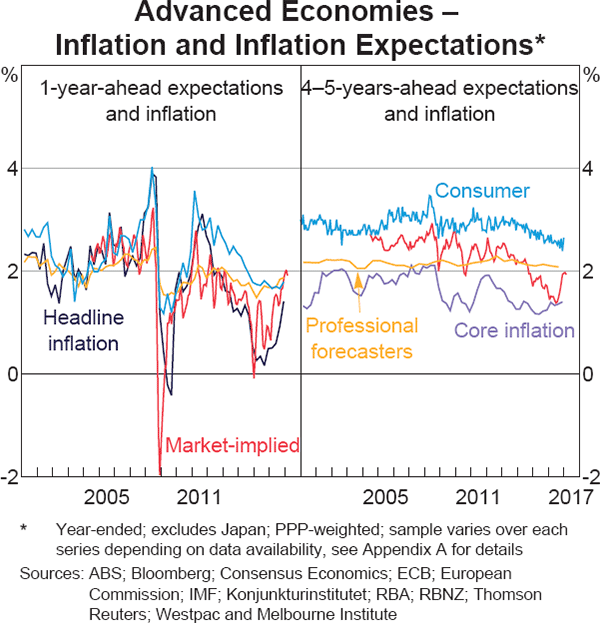
In general, long-term inflation expectations measures in the advanced economies have been more stable than the short-term measures. This reflects the credibility that economic agents assign to central banks in reaching their inflation targets once short-term shocks dissipate. However, some measures of longer-term inflation expectations have declined noticeably since late 2014. This could mean that expectations are no longer anchored at central banks' targets. How much this matters depends on how informative these measures are about future inflation. Long-term market-implied expectations declined the most; they drifted lower after the GFC, before declining sharply in late 2014 and early 2015.[10] However, in all economies, these measures have increased noticeably since late 2016. This could reflect improvements in the macroeconomic outlook, stabilisation in the oil price, or changes in inflation risk premia.[11]
Long-term consumer expectations are only available for the United States and the United Kingdom, where they have also steadily declined over the past three years. In contrast, long-term professional forecasters' survey measures have been relatively more stable over the post-crisis period.
How Well Do Measures of Inflation Expectations Forecast Future Inflation?
The divergence between inflation expectations measures over recent years, especially between the market-implied and professional forecasters' measures at longer horizons, raises a question about which expectations measures are better able to predict future inflation. If the measures that have been more stable, such as the surveys of professional forecasters, are better at predicting future inflation, this would suggest that inflation expectations have remained anchored and central banks are expected to continue to act in ways that ensure their inflation objectives are achieved. Conversely, if the market-implied measures – which have experienced larger declines over recent years – are better predictors of future inflation, this would suggest that underlying inflation is expected to be lower than many central banks' inflation targets. This would make the task of returning inflation to target more difficult, especially in an environment where policy rates are already low and unconventional monetary policy tools have been deployed extensively.
Comparing each inflation expectations measure to subsequently realised inflation shows both the predictive performance and anchoring of each measure. Graph 2 shows that long-term inflation expectations have tended to over-predict inflation (i.e. the dots lie below the 45-degree line), more so than shorter-term expectations.
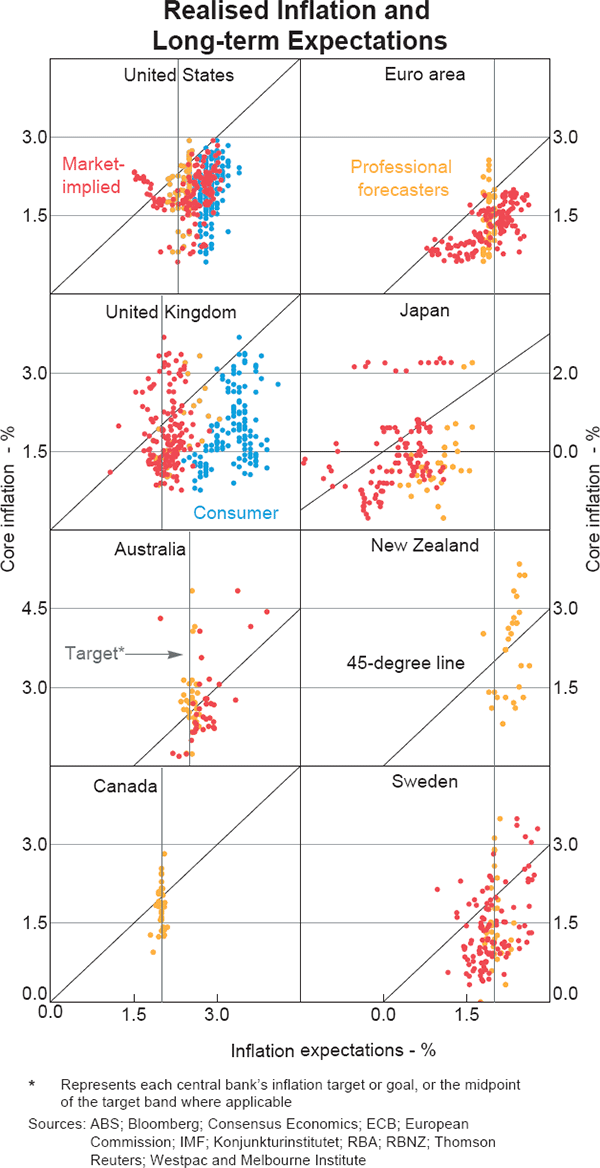
Inflation expectations are more anchored the closer they cluster around the central bank's inflation target (represented by the grey vertical lines in Graph 2). The longer-term professional forecasters' inflation expectations cluster closely to the inflation targets. In contrast, the market-implied and consumer inflation expectations measures are more dispersed. Longer-term consumer inflation expectations in the United States appear to be fairly closely clustered but at a level higher than the Federal Reserve's inflation goal.[12]
More formally, the relative forecasting performance of an inflation expectations measure can be evaluated based on:
- bias; the average difference between the inflation expectations measure and realised inflation over the relevant horizon; and
- root mean squared error (RMSE); the average distance (measured by the squared difference) between the inflation expectations measure and realised inflation over the relevant horizon.[13]
Measures with lower bias and a lower RMSE are better at predicting future inflation. It is necessary to use a common sample period for a consistent assessment of the relative performance of different inflation expectations measures. The market-implied measures have the shortest history because inflation swaps data are only available from 2004, which limits the period of assessment to 2005–16. This period is dominated by the low inflation experience since the GFC, which may affect the applicability of the results to the extent that the persistence of this low inflation environment was unexpected. To address this concern, the analysis is also extended to the pre-GFC period for professional forecasters' and consumers' expectations for economies where the data are available.
To provide further context, the bias and RMSE of the three types of inflation expectations measures can be compared against the forecasting performance of a simple statistical model (the ‘benchmark’ model). One such benchmark is a model where quarterly inflation only depends on the central bank's inflation target and last period's inflation. This captures the persistence of inflation, and assumes inflation returns to the central bank's target at a speed which is consistent with the historical experience.[14]
Expectations of headline inflation at the 1-year horizon are most appropriately compared with actual headline inflation over the subsequent year. At longer horizons, inflation expectations are compared with core inflation because it is unlikely that economic agents can, or indeed attempt to, accurately anticipate shocks to the prices of volatile items, such as energy, when forming their longer-term inflation expectations.[15]
Bias
Inflation expectations measures since 2005 have been upwardly biased (Graph 3).[16] That is, in most economies and at most horizons (up to 5 years ahead) inflation expectations measures have been, on average, higher than realised inflation over the period referenced by the inflation expectation measures. While there is some variation across the advanced economies, in general, inflation expectations have been less biased and more accurate at forecasting inflation in the near-term.
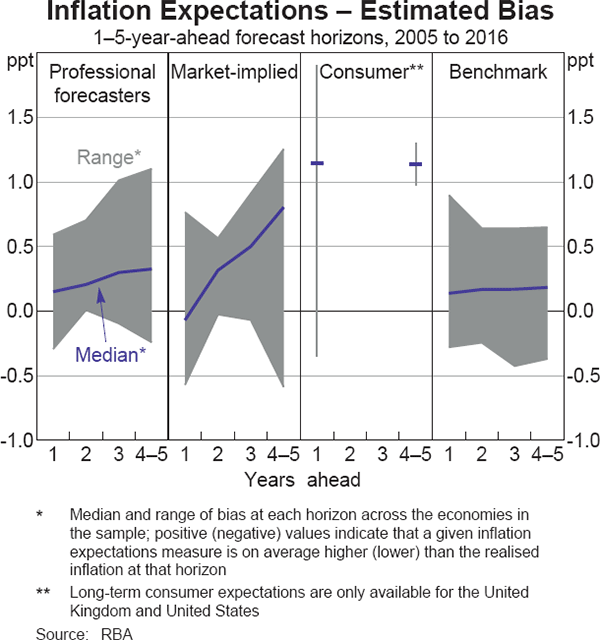
Professional forecasters have tended to have the least biased expectations, particularly at longer horizons. Their bias beyond the 1-year horizon is statistically significant in most cases.[17] However, in Australia, New Zealand and the United Kingdom, professional forecasters' inflation expectations measures appear to be unbiased at all horizons.
Market-implied measures are positively biased beyond the 1-year horizon, and this bias increases with the length of the forecast horizon. This is largely as expected, because risk premia should drive a positive wedge between the true, but unobserved, inflation expectations of swap market participants and the forward rate, and this difference should increase with the horizon.[18] Market-based inflation expectations measures appear to be unbiased at all horizons in Japan and the United Kingdom. However, the relatively short sample of the Japanese market-implied measures, combined with the effects of the 2014 consumption tax increase, suggest that this conclusion may not hold over longer and more representative periods of time; the effects of the consumption tax increase would not have been incorporated into inflation forecasts made before it was announced in 2012.
Consumer inflation expectations measures are also upwardly biased, reflecting respondents' personal experience and financial literacy (Ballantyne et al 2016).[19] It is unclear whether the bias in consumer expectations increases with the length of the forecast horizon; the bias increases with the forecast horizon in the United Kingdom, but is broadly similar in the United States across horizons.
The bias in most inflation expectations measures has increased at all horizons in recent years (Graph 4). The increase has been the largest for consumers, who have consistently expected inflation to be higher than it has been since around 2009. Professional forecasters' inflation expectations have been the least biased at longer-term horizons since the early 2000s. Prior to this, their bias had declined, possibly reflecting an adjustment to the wide-spread adoption of inflation targeting regimes by central banks in the 1990s. The bias of longer-term market-implied inflation expectations measures has been high and relatively stable over time. The lower bias of the professional forecasters relative to the other available expectations over the extended period of time is consistent with the results from the shorter common sample period.
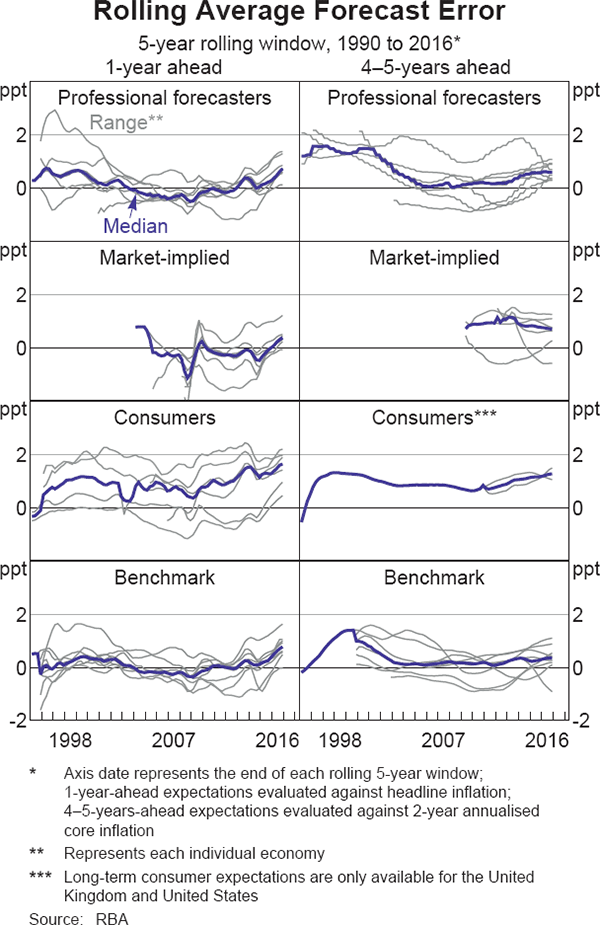
Root mean squared errors
The second aspect of forecasting performance is the accuracy of the forecast. A forecast that is more biased may still be preferred if its variance is sufficiently small.[20] That said, the ranking of the three expectations measures based on their RMSE since 2005 is the same as the ranking based on their bias. Professional forecasters' inflation expectations have been more accurate at anticipating future inflation than those of markets or consumers at all horizons (Graph 5).
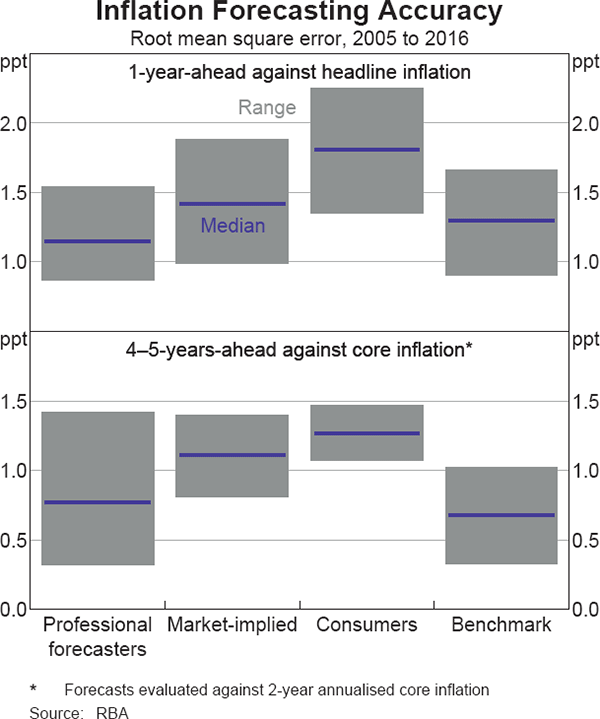
The market-implied measures have, in turn, been more accurate than the consumer inflation expectations measures. As was the case with the bias, the inflation expectations measures' RMSE increases with the length of the forecast horizon.[21]
The difference between the RMSEs of the professional forecasters and the market-implied measures is not statistically significant at shorter horizons.[22] This, together with their similar bias at the 1-year horizon, points to the two types of measures having similar information content about future inflation at shorter horizons. The professional forecasters' and market-implied inflation expectations tend to be at least as accurate as the simple statistical benchmark in forecasting near-term inflation.[23]
At longer horizons however, professional forecasters are statistically more accurate than longer-term market-implied expectations in most economies. Of the three measures, only the professional forecasters' inflation expectations are as accurate as the simple statistical benchmark (both market-implied and consumer measures are statistically less accurate).
Professional forecasters have generally produced the most accurate forecasts of inflation since the late 1990s, consistent with the results from the post-2005 common sample period (Graph 6). Since the GFC, the accuracy of short-term professional and consumer inflation expectations has declined, especially at longer horizons. The accuracy of the short-term market-implied measures has varied significantly since the mid 2000s.
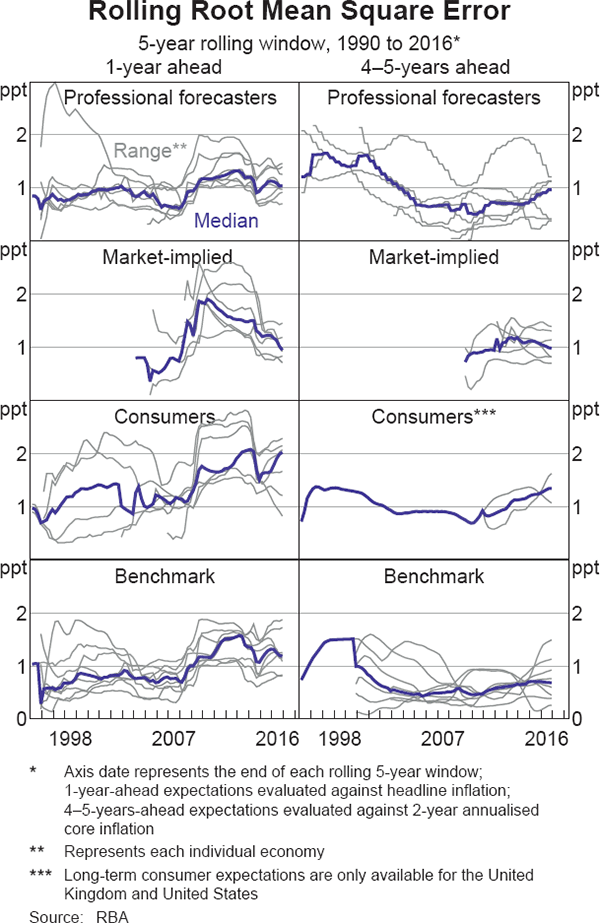
Conclusion
The forecasting ability of inflation expectations measures in advanced economies has been mixed. Consumer inflation expectations measures are the least accurate at predicting future inflation. Market-implied measures have been able to anticipate inflation accurately over the subsequent year, but they have tended to over-predict inflation at longer horizons. Market-implied measures tend to have relatively large bias and forecast errors at longer horizons, although this bias has decreased a little over the past couple of years. In general, professional forecasters' inflation expectations have been the least biased and the most accurate at predicting future inflation. Given their better forecasting performance, the inflation expectations of professional forecasters should receive the most weight in assessing changes in inflation expectations. Still, other measures should continue to be monitored because they provide more timely information on potential developments (e.g. market-implied measures) or represent the expectations of particular groups of economic agents that are relevant in setting prices and wages (e.g. consumers).
Over recent years, longer-term professional forecasters' inflation expectations measures have been relatively stable while the market-implied and consumer measures have declined since 2014. The stability of the professional forecasters' longer-term inflation expectations at around central banks' inflation targets may alleviate concerns about inflation expectations in advanced economies becoming less well anchored. Supporting this interpretation, market-implied measures have also retraced some of their earlier declines since mid 2016. The high volatility in recent years and the relatively poor forecasting performance of market-implied expectations suggest that these measures should be interpreted with caution.
Appendix A
| Type | Measure | Horizon | Start | Frequency | |
|---|---|---|---|---|---|
| United States | Financial market | Swaps-implied | 1–10 years | 2004 | Intraday |
| Professional survey | Federal Reserve Bank of Philadelphia Survey of Professional Forecasters | 1, 10 years | 1981 (1 year), 1991 (10 years) | Quarterly | |
| Professional survey | Consensus Economics | 3–5 years | 1989 | Semiannual | |
| Consumer survey | University of Michigan Survey of Consumers | 1, 5–10 years | 1978 | Monthly | |
| Euro area | Financial market | Swaps-implied | 1–10 years ahead | 2004 | Intraday |
| Professional survey | European Central Bank Survey of Professional Forecasters | 1, 2, 5 years | 1999 | Quarterly | |
| Professional survey | Consensus Economics | 3, 10 years | 2003 | Semiannual | |
| Consumer survey | European Commission Consumer Survey(a) | 1 year | 1985 | Monthly | |
| Japan | Financial market | Swaps-implied | 1–10 years | 2007 | Intraday |
| Professional survey | Consensus Economics | 1–10 years | 1994 (1, 2 years), 1989 (3–10 years) | Quarterly and semiannual | |
| Consumer survey | Cabinet Office Consumer Confidence Survey(b) | 1 year | 2004 | Monthly | |
| United Kingdom(c) | Financial market | Swaps-implied | 1–10 years | 2004 | Intraday |
| Professional survey | Consensus Economics | 1–10 years | 2004 | Quarterly and semiannual | |
| Consumer survey | YouGov Citigroup | 1, 5–10 years | 2005 | Monthly | |
| Australia | Financial market | Swaps-implied | 1–10 years | 2008 | Intraday |
| Professional survey | Consensus Economics | 1–10 years | 1994 (1, 2 years), 1991 (3–10 years) | Quarterly and semiannual | |
| Consumer survey | Westpac and Melbourne Institute Survey of Inflationary Expectations | 1 year | 1995 | Monthly | |
| New Zealand | Professional survey | Consensus Economics | 1–10 years | 1995 | Quarterly and semiannual |
| Consumer survey | RBNZ Household and Business CPI Expectations | 1 year (households), 2 years (businesses) | 1990 | Quarterly | |
| Canada(d) | Professional survey | Consensus Economics | 1–10 years | 1994 (1, 2 years), 1989 (3–10 years) | Quarterly and semiannual |
| Consumer survey | Bank of Canada Business Outlook Survey | 2 years | 2001 | Intraday | |
| Sweden | Financial market | Swaps-implied | 1–10 years | 2007 | Intraday |
| Professional survey | Consensus Economics | 1–10 years | 1995 | Quarterly and semiannual | |
| Consumer survey | Konjunkturinstitutet Household Survey | 1 year | 2001 | Quarterly | |
|
(a) The European Commission Consumer Survey asks consumers whether they
expect inflation to be higher, lower or unchanged relative to a prior
period, and reports the results as a diffusion index; for completeness
only, the euro area consumer inflation expectations diffusion index
is mapped to an inflation expectation by scaling the index to have
the same mean and standard deviation as the euro area headline inflation
between 1996 and 2016 Source: RBA |
|||||
| 1-year-ahead | 4–5-years-ahead | |||
|---|---|---|---|---|
| RMSE(a) | Bias(b) | RMSE(a) | Bias(b) | |
| Australia | ||||
| Professional forecasters | 1.00 | 0.15 | 0.68** | −0.24* |
| Market-implied | 1.09* | 0.17 | 0.81*** | 0.64*** |
| Consumers | 2.25*** | 1.90*** | ||
| Benchmark | 0.93 | −0.06 | 0.64 | −0.29*** |
| Canada | ||||
| Professional forecasters | 0.87 | 0.16 | 0.32 | 0.22*** |
| Market-implied | ||||
| Consumers | ||||
| Benchmark | 0.90 | 0.28* | 0.33 | 0.24*** |
| Euro area | ||||
| Professional forecasters | 1.07 | 0.05 | 0.69*** | 0.58*** |
| Market-implied | 0.99*** | −0.01 | 1.07*** | 1.04*** |
| Consumers | 1.35*** | −0.34 | ||
| Benchmark | 1.09 | 0.35* | 0.71 | 0.63*** |
| Japan | ||||
| Professional forecasters | 0.96*** | 0.15 | 1.43 | 1.10*** |
| Market-implied | 1.32*** | −0.13 | 1.40 | −0.59* |
| Consumers | 2.06*** | 1.90*** | ||
| Benchmark | 1.65 | 0.01 | 1.01 | −0.37** |
| New Zealand | ||||
| Professional forecasters | 1.23 | 0.35* | 0.94* | −0.01 |
| Market-implied | ||||
| Consumers | 1.81** | 1.30*** | ||
| Benchmark | 1.36 | −0.10 | 0.82 | −0.26* |
| Sweden | ||||
| Professional forecasters | 1.40*** | 0.59*** | 0.86 | 0.65*** |
| Market-implied | 1.61* | 0.77*** | 1.31** | 1.26*** |
| Consumers | 1.58 | 0.87*** | ||
| Benchmark | 1.54 | 0.90*** | 0.84 | 0.65*** |
| United Kingdom | ||||
| Professional forecasters | 1.36 | −0.29 | 0.89** | 0.12 |
| Market-implied | 1.53** | −0.57** | 1.15*** | −0.03 |
| Consumers | 1.37 | 0.15 | 1.46*** | 1.30*** |
| Benchmark | 1.24 | −0.28 | 0.61 | 0.13 |
| United States | ||||
| Professional forecasters | 1.53 | 0.07 | 0.56 | 0.43*** |
| Market-implied | 1.88** | −0.33 | 1.06*** | 0.98*** |
| Consumers | 2.14*** | 1.15*** | 1.07*** | 0.98*** |
| Benchmark | 1.52 | 0.26 | 0.52 | 0.38*** |
|
(a) *, ** and *** indicate statistical significance at the 10, 5 and
1 per cent levels, respectively, between the difference in forecasting
performance between the RMSE of the measure of inflation expectations
and the benchmark using a two-sided Diebold-Mariano test with quadratic
loss; rejecting the null hypothesis suggests that accuracy of the measure
of inflation expectations and the benchmark are not equal Source: RBA |
||||
Footnotes
The authors are from Economic Analysis Department. [*]
For a detailed discussion of these measures in the Australian context, see Moore (2016). [1]
A summary of the inflation expectations measures used in this article is provided in Appendix A. This analysis does not consider the expectations of businesses, except in the case of Canada and New Zealand at the 2-year-ahead horizon where they are used as proxies for consumer expectations. [2]
For more information on the risk premia embodied in both inflation swaps and inflation-linked bonds, see European Central Bank (2014) and Moore (2016). Finlay and Wende (2011) decompose inflation expectations and risk premia for Australia. [3]
There is evidence that inflation risk premia vary over time, making it difficult to attribute movements in the market-based measures as changes in underlying expectations or inflation risk premia (Moore 2016). Imakubo and Nakajima (2015) find evidence that inflation risk premia declined in both Japan and the United States in 2014. [4]
For example, Moore (2016) finds that activity in the Australian inflation swap market is low and prices may reflect the views of just a small number of market makers. [5]
The market for inflation-linked government bonds has existed for longer than the market for inflation swaps. However, constructing consistent market-implied measures of inflation expectations requires inflation-linked bonds with a range of maturities at each point in time; the range of maturities is limited and varies through time in most economies. This limits the ability to assess the forecasting performance of market-implied measures from inflation-linked bonds that abstracts from the effects of near-term inflation developments. For further discussion of bond- and swap-implied inflation expectations, see Finlay and Olivan (2012). [6]
For example, Croushore (1997, p3) argues that where forecasts are attributed to individual forecasters, ‘participants might shade their forecasts more toward the consensus (to avoid unfavourable publicity when wrong), while others might make unusually bold forecasts, hoping to stand out from the crowd.’ [7]
For example, while most surveys directly ask participants what they expect the rate of inflation to be over a specific horizon, the European Commission's survey asks euro area consumers whether they expect inflation to be higher, lower or unchanged relative to a prior period and report the results as a diffusion index. The Japanese survey reports the distribution of survey responses about expected inflation. [8]
‘Long-term’ refers to expectations about inflation at least 4–5 years into the future; ‘short-term’ refers to expectations of 1–2 years ahead. Typically, long-term measures are more stable than short-term measures because developments in headline inflation are harder to predict further into the future. As a result, long-term measures can reasonably be considered as reflecting forecasters' beliefs about whether a given central bank will achieve its inflation target. [9]
This was true in particular for the euro area, Sweden and the United States. In contrast, market-implied expectations in Japan picked up sharply in early 2013, following the Bank of Japan announcing its quantitative and qualitative monetary easing program and introducing its 2 per cent inflation target. Japanese market-implied inflation expectations then fell sharply over the second half of 2015 and early 2016 (a year later than the other advanced economies), as inflation remained persistently low and the yen appreciated. [10]
To some extent movements in market-implied inflation expectations, even at longer horizons, have coincided with movements in the oil price. The correlation between the longer-term market-implied inflation expectations and oil prices is puzzling as oil price changes should not affect inflation at longer horizons. For more information, see Darvas and Hüttl (2016). [11]
The Federal Reserve's inflation goal is for 2 per cent inflation as measured by the price index of personal consumption expenditure (PCE). However, US inflation expectations measures either reference CPI inflation explicitly (professional forecasters and market-implied), or do not reference a specific inflation index (consumer). Therefore, the US inflation expectations measures are compared to 2.3 per cent – the Federal Reserve's inflation goal plus the average difference between core CPI and core PCE inflation since 2000 (Federal Reserve Bank of Cleveland 2014). [12]
See Mincer and Zarnowitz (1969) for further details on evaluating forecasts. Formally,
for a forecast  of a variable
θ the bias is
of a variable
θ the bias is  and the RMSE is
and the RMSE is
 .
[13]
.
[13]
More formally, the statistical benchmark follows an autoregressive process of order one, estimated recursively from 1990 with the long-run mean constrained to equal the relevant inflation target. The Bank of Japan and the US Federal Reserve established explicit inflation goals or targets only recently; 2011 in the United States and 2013 in Japan. Even before establishing its explicit inflation goal in 2011, it was widely assumed that the Federal Reserve's goal was to achieve inflation of around 2 per cent (for an example of this see the Federal Open Market Committee's Summary of Economic Projections long-term inflation forecasts, which were generally between 1.7 and 2 per cent from 2007 to the introduction of the formal inflation goal in 2011). As such, this inflation goal is used as the inflation target even before 2011. For Japan, where inflation has been persistently low and often negative, and the inflation target was only recently implemented, the statistical benchmark assumes that inflation in future periods remains at its current level. [14]
Faust and Wright (2013) suggest that, even if forecasters are trying to predict headline inflation, they may be better off forecasting core inflation and then using this as if it were a prediction of overall inflation. [15]
Detailed estimates of the bias and the RMSE for each economy in the sample at the 1-year and the 4–5-year horizons are available in Appendix A. [16]
The bias is formally assessed with regressions of the forecast errors of an inflation
expectations measure (inflation expectations measure less inflation at
the relevant horizon) on a constant using autocorrelation-robust standard
errors  and testing the statistical significance at the 5 per cent level of the estimated
bias
and testing the statistical significance at the 5 per cent level of the estimated
bias  .
[17]
.
[17]
Haubrich, Pennacchi and Ritchken (2012) find that inflation risk premia are positive and increasing in maturity in the United States. Hördahl and Tristani (2010) find the same result in both the euro area and United States. [18]
Two exceptions are the United Kingdom, where consumer inflation expectations at the 1-year horizon are unbiased, and in New Zealand, where business expectations at the 2-year horizon are unbiased. [19]
The RMSE is a function of the bias and the variance of the forecast:  . Between two forecasts, the more biased one can have a lower RMSE if and only if
it has a sufficiently smaller variance.
[20]
. Between two forecasts, the more biased one can have a lower RMSE if and only if
it has a sufficiently smaller variance.
[20]
A visual inspection of Graph 5 suggests that the RMSE of each expectations measure is larger at the 1-year horizon. This reflects the fact that 1-year ahead inflation expectations are evaluated against headline inflation, while longer-term horizons are evaluated against core inflation which is less volatile. The pattern of increasing RMSE with the forecast horizon is apparent when evaluating expectations against core inflation at 2-, 3- and 4–5-year horizons. [21]
The statistical significance of the differences in RMSEs between two inflation expectations measures is assessed with the Diebold-Mariano test using a quadratic loss function. For further details on this procedure, see Diebold (2013). [22]
Grothe and Meyler (2015) find similar results, i.e. that market-implied and professional forecasts are statistically at least as accurate as a simple auto regressive process and a random walk in the United States and the euro area at 1- and 2- year-ahead horizons. [23]
References
Ballantyne A, C Gillitzer, D Jacobs and E Rankin (2016), ‘Disagreement about Inflation Expectations’, RBA Research Discussion Paper No 2016-02.
Bank of England (2014), ‘Section 4: Costs and Prices’, Inflation Report, February, pp 31–37.
Croushore D (1997), ‘The Livingston Survey: Still Useful After All These Years’, Federal Reserve Bank of Philadelphia Business Review, March/April, pp 1–12.
Darvas Z and P Hüttl (2016), ‘Oil Prices and Inflation Expectations’, Bruegel Blog, viewed 24 February 2017.
Diebold F (2013), ‘Comparing Predictive Accuracy, Twenty Years Later: A Personal Perspective on the Use and Abuse of Diebold-Mariano Tests’, Journal of Business and Economic Statistics Invited Lecture, Allied Social Science Association Meetings, Philadelphia.
European Central Bank (2014), ‘Box 4: Inflation Risk Premia in Market-based Measures of Inflation Expectations’, Monthly Bulletin, July, pp 34–36.
Faust J and JH Wright (2013), ‘Forecasting Inflation’, in G Elliott, C Granger and A Timmermann (eds), Handbook of Economic Forecasting, Volume 2, Elsevier, Amsterdam, pp 2–56.
Federal Reserve Bank of Cleveland (2014), ‘PCE and CPI Inflation: What's the Difference?’, viewed 24 February.
Finlay R and D Olivan (2012), ‘Extracting Information from Financial Market Instruments’, RBA Bulletin, March, pp 45–54.
Finlay R and S Wende (2011), ‘Estimating Inflation Expectations with a Limited Number of Inflation indexed Bonds’, RBA Research Discussion Paper No 2011-01.
Grothe M and A Meyler (2015), ‘Inflation Forecasts: Are Market-based and Survey-based Measures Informative?’, European Central Bank Working Paper No. 1865.
Haubrich J, G Pennacchi and P Ritchken (2012), ‘Inflation Expectations, Real Rates, and Risk Premia: Evidence from Inflation Swaps’, The Review of Financial Studies, 25(5), pp 1588–1629.
Hördahl P and O Tristani (2010), ‘Inflation Risk Premia in the US and the Euro Area’, European Central Bank Working Paper No. 1270.
Imakubo K and J Nakajima (2015), ‘Estimating Inflation Risk Premia from Nominal and Real Yield Curves Using a Shadow-rate Model’, Bank of Japan Working Paper 15-E-1.
Mincer JA and V Zarnowitz (1969), ‘The Evaluation of Economic Forecasts’ in Economic Forecasts and Expectations: Analysis of Forecasting Behavior and Performance, National Bureau of Economic Research, Cambridge, pp 3–46.
Moore A (2016), ‘Measures of Inflation Expectations in Australia’, RBA Bulletin, December, pp 23–31.
 , from the regression
, from the regression
 estimated with autocorrelation-robust
standard errors; *, ** and *** indicate statistical significance at
the 10, 5 and 1 per cent levels, respectively
estimated with autocorrelation-robust
standard errors; *, ** and *** indicate statistical significance at
the 10, 5 and 1 per cent levels, respectively